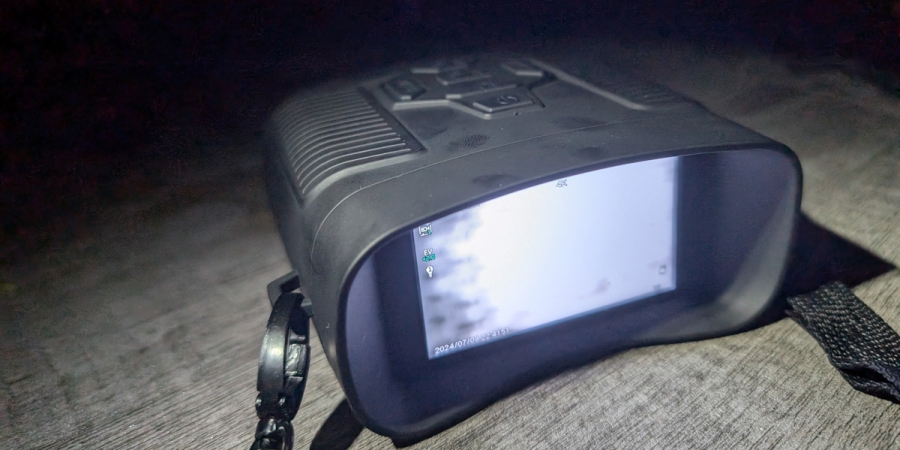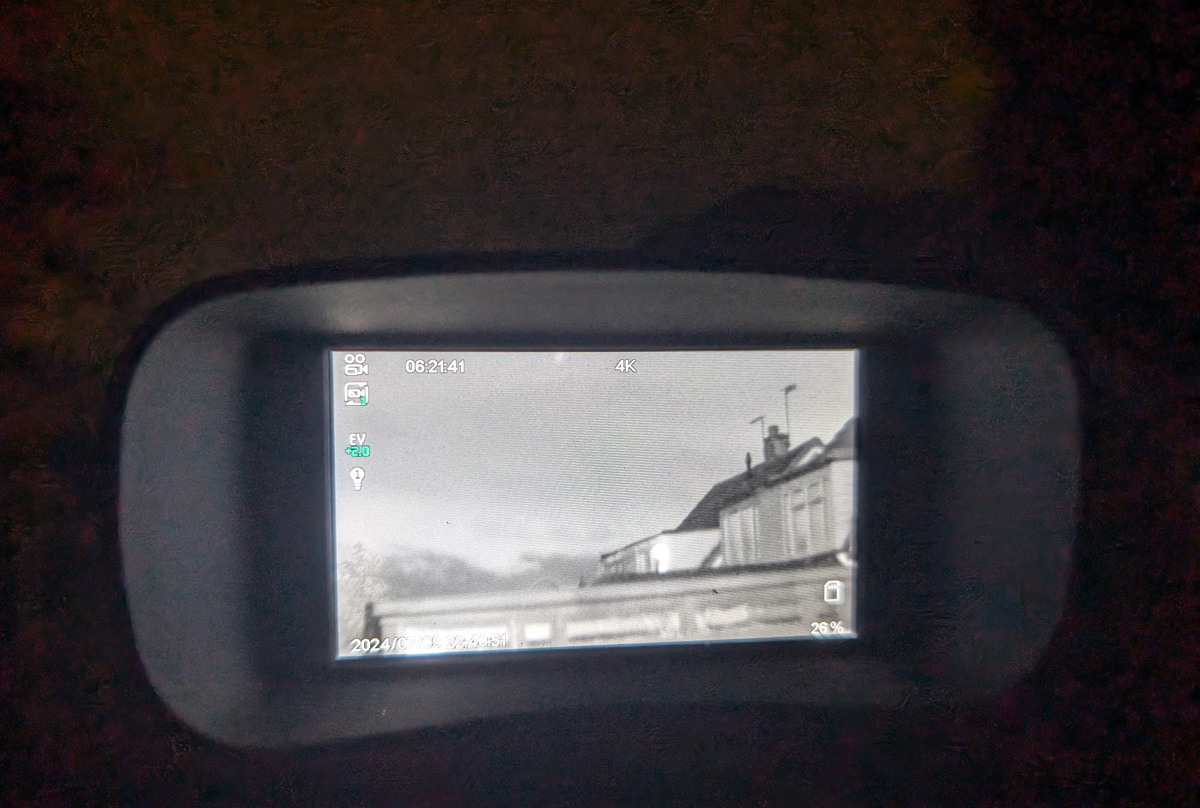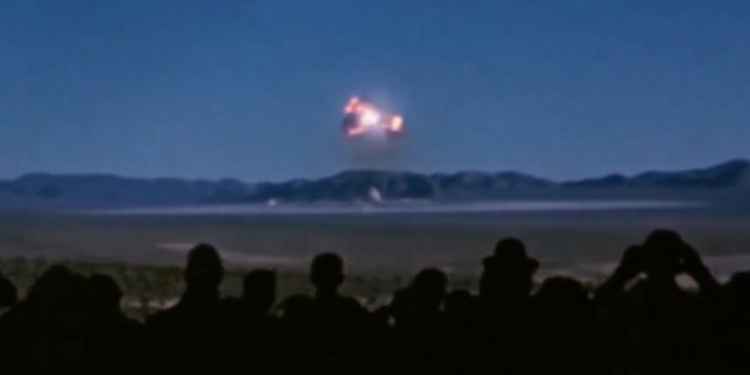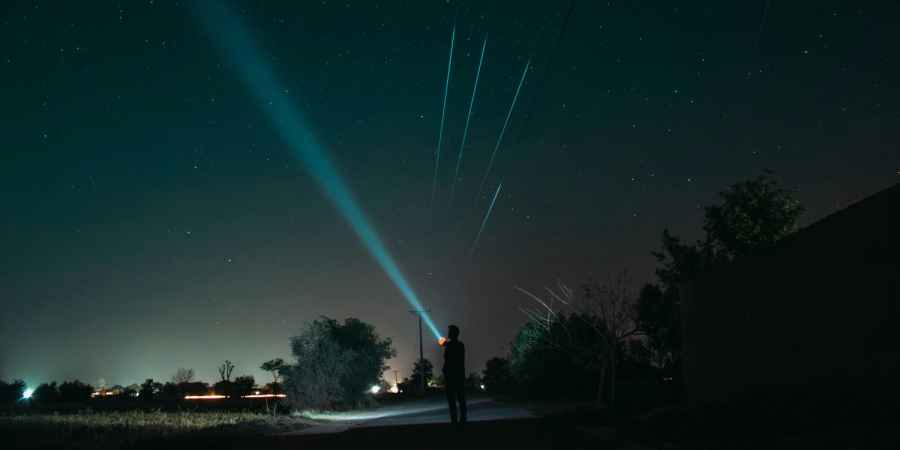

I recently purchased a pair of cheap digital infrared binoculars that I plan to use on an upcoming UFO skywatch event, but how do their features stack up and would they make a good tool in the field?
Initially, I wanted some traditional optical binoculars like I'd used to attempt to spot UFOs as a teen, but a pair with the addition of recording and night vision capabilities. I quickly found that such a combination doesn't really exist, at least not in the consumer market.
Most digital binoculars on the market have a single digital screen that functions as a viewfinder rather than the traditional optical eyepieces you get with real binoculars. This means they function more like a camcorder but offer a binocular-like experience. This does make the device less immersive than binoculars, and since there's only one screen, they actually function as more of a monocular than traditional binoculars, but they do allow for efficient scanning of the sky, which is what I mostly wanted.
When I realised this, I opted for a cheaper model, as the difference in performance between affordable and high-end models seemed minimal. The main distinction between more expensive versions was often a better zoom, but many only offered digital zoom.
I opted for the Relassy 4K HD Digital Infrared Binoculars, which are primarily aimed at the birdwatching and hunting markets, and they cost me under £60 from Amazon.
Although I haven't attended the event yet, I've tested some features of these binoculars. The night vision is particularly impressive when used to view objects and scenes within a reasonable distance on the ground. The binoculars have seven different infrared illuminator settings for various brightness levels, but even without the infrared illuminator, you still get clear images, thanks to their high sensitivity to light.
Of course, when you point binoculars at the sky, the infrared illuminator is somewhat redundant, since it would fail to illuminate the whole night sky. Trying to do so is akin to turning on the flash on a camera to take a picture of an open landscape at dusk. When it comes to space, celestial objects are often self-illuminating, or at the very least illuminated by the Sun, so lights aren't really necessary.
Even a UFO will probably have its own lights, if not, it would not only be invisible to the binoculars but effectively invisible however you try to observe it from Earth. However, since the binoculars are sensitive to infrared light, this does mean you might be able to capture images that aren't visible to the naked eye - those that might emit light in the infrared range.

The device is also rechargeable and comes with a neck strap, adding to its practicality. The tripod mount is another useful feature, enabling stable and controlled viewing, which is crucial since the device lacks built-in image stabilisation. The manual focus, while adding to the traditional feel, offers precise control over the image, which is beneficial for observing various celestial objects.
The manual focus adjustment is conveniently located on one of the "lenses" on the front of the binoculars, making it easy and accessible. On closer inspection, you'll realise that only one of these protrusions on the front is a lens, the other houses the infrared illuminator.
Interestingly, my affordable binoculars default to a 2x optical zoom, which is actually better than some pricier digital models that only offer digital zoom. Mine also has a 5x digital zoom, though I find the digital zoom less useful as it degrades video quality. The fixed 2x magnification offers a consistent field of view, making it feel more like traditional binoculars, even if it can't zoom out to 1x.
One significant advantage of these digital binoculars is their ability to record in 4K. This feature ensures I can capture and review any fleeting phenomena I might observe during the skywatch. Admittedly, the footage it captures might not be top-tier, but it is still quite good for its price.
One really useful feature for a skywatch is the one-minute looped recording functionality. This feature continuously records and saves the latest minute of footage, ensuring that you don't miss any sudden or unexpected events without ending up with hours of footage to sift through. On a skywatch, this can be particularly useful for capturing brief flashes or quick movements in the sky that you might not have been prepared for. Instead of continuously recording and filling up storage with long, uneventful segments, the looped recording allows you to focus on key moments without worrying about missing crucial evidence.
While primarily intended for skywatching, these night vision binoculars could also prove useful on a ghost hunt thanks to their good night vision capability, especially with the variable IR illuminator brightness. The fixed 2x zoom could be a limitation in smaller environments, but in open spaces or large rooms, it can be quite effective for spotting activity from a distance, making it quite suitable for such investigations. However, like with skywatching, the lack of image stabilisation may result in shaky footage.
Overall, these digital binoculars seem well-suited for my needs, combining affordability with useful features. Surprisingly, it even came with a 32GB memory card. They're far from high-end, but they are what I would expect for the price range. Their biggest drawback, in my opinion, is the lack of image stabilisation.
The specific pair I bought are four-star-rated on Amazon, and other customers say they like the ease of use of the binoculars, as well as the value for money, but people's opinions on the video quality is mixed in the reviews. One review reads, "difficult to focus and difficult to keep steady, you need to use a tripod all the time." While another wrote, "Put these up against some twice the price, and it's hard to tell which is the cheap pair. Well worth the money."
I look forward to using them in a dark sky area, where the night vision and 4K recording should help me capture and review any interesting phenomena we might observe.
More On UFOs
See All
ArrayMarch 21, 2025
8 UFO/UAP Documentaries You Have To See

ArrayMarch 15, 2025
Today Is World Contact Day - Here Are 5 Ways You Can Try To Contact Aliens

ArrayMarch 04, 2025
The Most Famous & Influential UFO Whistleblowers Of All Time

ArrayFebruary 28, 2025
Robbie Williams Says UFO Came So Close, He Could Have Touched It
Learn With Higgypop
Hosted by Paralearning in association with Higgypop, these courses on ghost hunting, paranormal investigations, and occult practices draw on the experience of our team of paranormal writers.

Diploma In Practical Ghost Hunting & Scientific Analysis
This course gives you practical and useful knowledge of ghost hunting and paranormal research, which is invaluable when conducting your own paranormal investigations or as part of a group event.
View Course
Diploma In Capturing & Analyzing Electronic Voice Phenomenon
This course gives you practical and useful knowledge of ghost hunting and paranormal research, which is invaluable when conducting your own paranormal investigations or as part of a group event.
View CourseMore Like This

UfosMarch 21, 2025
8 UFO/UAP Documentaries You Have To See

AliensMarch 15, 2025
Today Is World Contact Day - Here Are 5 Ways You Can Try To Contact Aliens

Big CatsMarch 12, 2025
Elusive Orang Pendek & Sumatran Tiger Discovery Captured In Groundbreaking Expedition

UfosMarch 04, 2025
The Most Famous & Influential UFO Whistleblowers Of All Time
 See More on Audible
See More on Audible

Comments
Want To Join The Conversation?
Sign in or create an account to leave a comment.
Sign In
Create Account
Account Settings
Be the first to comment.